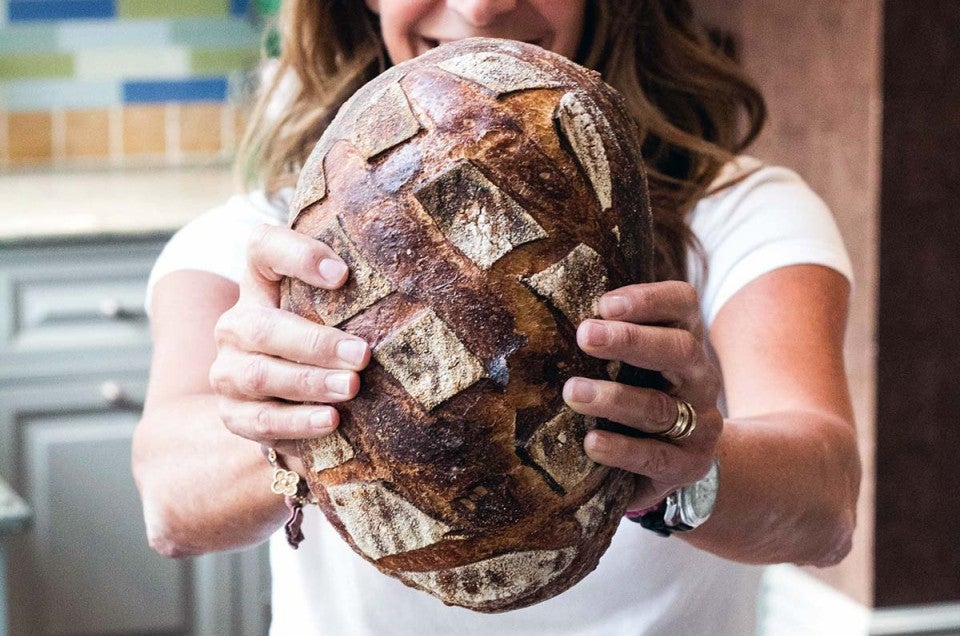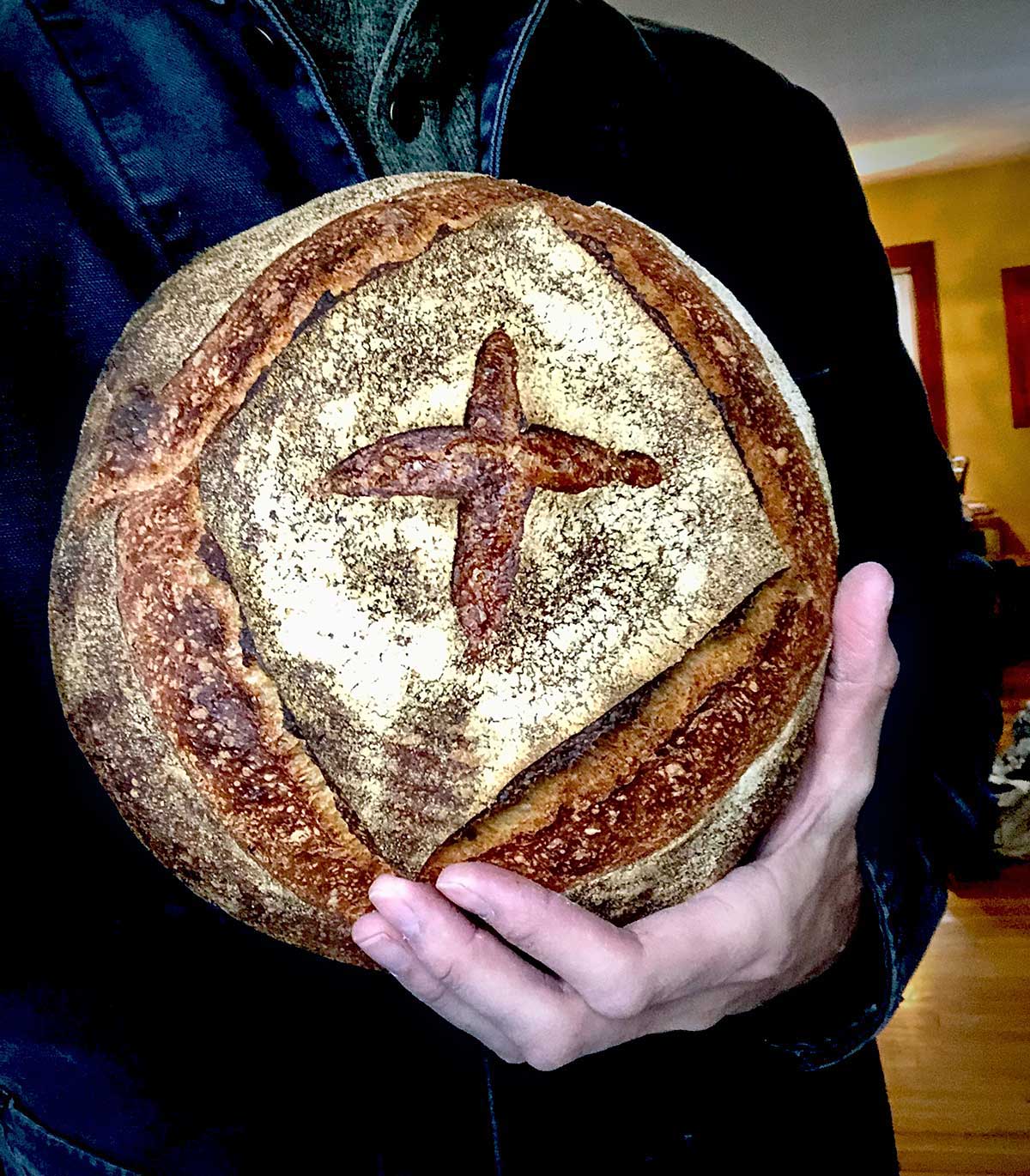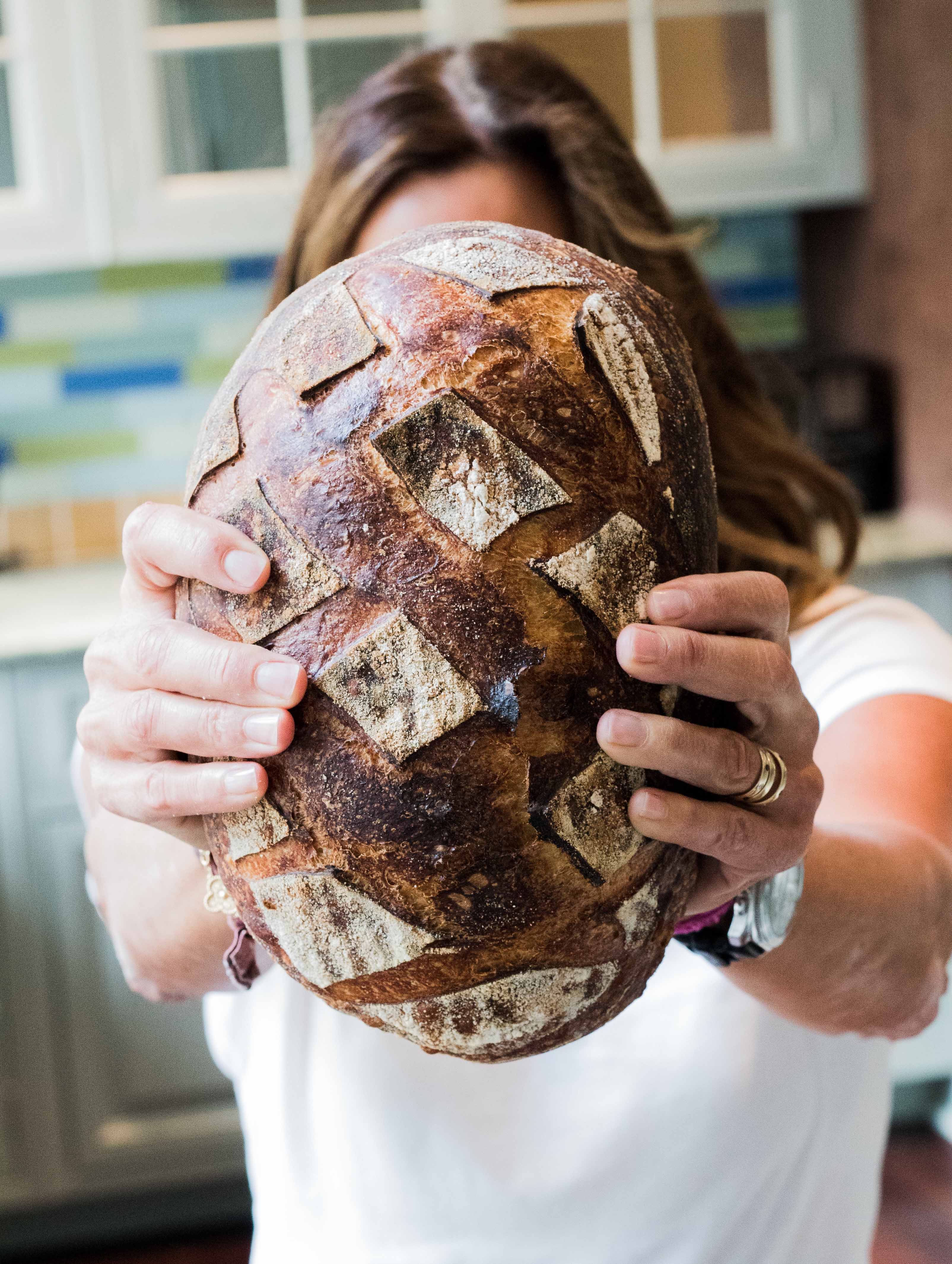


Bakers are friendly people. So friendly, in fact, that they ping my phone at all hours. Sometimes it’s a question (Hey! Where can I get those proofing baskets!?) or a picture of a great bake (Check this out!!! Jealous?) or a request for a recipe (Send me that Rye Pretzel pls). The conversation is open — you don’t need an intro — just let the random texts fly!
Recently, one of these exchanges changed the way that I make bread at home.
Maura: I’m not using preferments. I just use starter from the fridge ...
Me: No preferment??!
Maura: Nope
Me: How much bulk fermentation?
Maura: 12 hours ... it works ...
Me: ???? Send me a picture
Maura Brickman, a serious home baker in Connecticut, followed up her text with a picture of a large crusty loaf with gorgeous color. It was bakery quality by anyone’s standard — and she made it with "unrefreshed starter," straight from the refrigerator.

As a baker, convention has been my path to reliable results. I trust what I have done before — I know how to produce reliable results.
Maura doesn't care about convention. Free of “should” and “ought to,” she bends her breadmaking process to fit her busy schedule. She doesn’t take any guff from her starter or loaves — she's the boss of her bread.
After some thought about her method and convinced that there must be a flaw, I decided to give the Boss’ method a shot.
Before I outline her process, let me quickly clarify standard procedure: the way things normally go.
Sourdough bread traditionally begins with a preferment — a dough set for 12 to 18 hours to develop flavor — followed by mixing and bulk fermentation. After bulk, we divide, shape, proof (either at room temperature or chilled until the next day), and bake.
Maura alters this process to fit her day. Remember: She’s the boss! Rather than setting a preferment, she skips directly to the final mix, using a small amount of starter that she feeds once a week and keeps in the refrigerator to leaven her sourdough bread. After the mix, her dough rises for approximately 12 hours before the divide and shape.

If you've read the piece that I wrote about preferments and flavor, you’ll know that I think they're the difference between run of the mill and a loaf you’ll remember. In this method, which skips the preferment, flavor comes from the long bulk fermentation. We’ve got flavor covered — just in an unorthodox way.
But why not just go with the normal process? Here’s the answer.
Have you ever been a bread hostage? Did you ever feel like, “I’d love to make bread but I don’t have a half day to do so.” Or, “I’d love to attend your wedding, but I might be making bread that day.” At my house, there's quite a bit of coming and going. While I enjoy the opportunity to slow down and make beautiful things, there are also days where I just need to put great sourdough bread on the table.
As a professional baker, the needy schedule of bread and pastry can rule my day. But when I’m on my own time, it can be a challenge to fit everything in. Does this ring a bell?
Maura’s system offers several points of relief. First, it allows me to limit my dough interactions to the beginning or end of the day (no more “take your dough to work” scenarios).
Second, I don’t have to plan too far ahead if I want to mix up a dough (remember, no preferment, just grab some starter and go).
And last, there's no discard. I can thumb past all the delicious recipes for discarded starter, which (although amazing!) I may or may not have time to try.
Here’s Maura's process.

Maura usually starts after dinner, around 8 p.m. Like many serious bread bakers, she measures her ingredients exclusively by weight, so I’m going to do the same in this article. She also tracks the temperature of her ingredients. In this case, all dry ingredients should be room temperature, 70 to 72°F.
In a 6-quart container, combine the following:
900g King Arthur Unbleached Bread Flour
100g King Arthur Whole Wheat or Golden Whole Whole Wheat
800g tepid water (75°F to 80°F )
20g salt
40g sourdough starter, unfed/discard
Use starter straight from the fridge, though it’s best if fed within the past week.
Mix the ingredients by hand until the dough forms a shaggy mass and the flour is hydrated.
Set a 15-minute timer and leave the dough in the container at room temperature with the lid on.

At 15 minutes, return to the container and fold by pulling the sides of the dough up with a wet hand, then pressing to the middle to seal. Repeat this on all four sides, then set the timer again for 15 minutes.
Wait and fold the dough two more times. As you perform the folds you’ll notice that the dough smooths out, gaining strength and becoming elastic (more like a rubber band).
Leave the dough covered tightly at room temperature (approximately 72°F) overnight (about 12 hours). If using a mixing bowl, place the bowl in a plastic bag. If using a 6-quart container, just put the lid on — the main point here is that the dough should be well-covered to keep the exposed surface moist.

At 8 a.m. the next day (don’t be too uptight here — it could be 7 a.m. or 9 a.m.), divide the dough into two pieces. Gently form them into rounds, seam-side down, and rest for 10 minutes, covered.
Generously and evenly dust two lined bannetons with whole wheat flour.

Shape the loaves into boules or batards. If your dough doubled on the overnight rise (the marked 6-quart container will help with judging this), put the loaves straight into the refrigerator. If it's risen by just 50%, leave the loaves out for a bit (30 to 60 minutes) and then put them in the fridge. Note that the loaves should be covered with a shower cap or plastic bag.
Maura’s baking schedule (which is essentially a daily habit — no wonder she’s so good at it!) aligns well with her generous nature. Some days she bakes in the morning and distributes loaves to friends or neighbors. When her kids are home from college, she adjusts; they can easily polish off a loaf with dinner.
To bake, preheat two Dutch ovens — approximately 4-quart size — in a 500°F oven for 45 minutes. (Make sure your Dutch ovens are tough enough to be preheated empty; not all are. Check the manufacturer's literature.)
Invert the risen loaves onto a sheet of parchment, score with a lame, and carefully place the dough in the preheated Dutch ovens. Replace the lids and return to the oven.

Reduce the oven temperature to 450°F and bake for 20 minutes with the lids in place.
After 20 minutes, remove the lids and bake for another 20 to 25 minutes, or until the loaves have deep color.
After a few months of making Maura’s bread and receiving lots and lots of feedback from my family (often with a mouth full of bread), it’s become our daily loaf — the one that sits on our breadboard next to the butter. I’ve shared the process (via text) far and wide and have watched many people take on the role of Bread Boss.
As I’m an endless tinkerer and bread obsessed, I've adapted the recipe slightly. Here are some notes:
I use the same amount of flour (1,000g) but divide it differently. I use 750g of King Arthur Unbleached All-Purpose Flour. It’s strong enough for a good artisan loaf and it’s my Flour Power for the non-whole grain portion of just about everything in the house.
For the remaining 250g, I use a mixture of whatever flour I have on hand: whole wheat, golden whole wheat, whole rye, whole spelt, or even a little bit of buckwheat. I use a different blend of whole grains almost every time. My loaf is a little darker than Maura’s, but I love the flavor of the grains.

For water, I've lowered Maura’s quantity slightly. During cool months, I do need to warm my water to over 90°F; in warmer seasons, when my house isn't 60°F, I'll likely use 65°F water.
In early tests, my dough seemed a little sluggish. My Vermont wood-heated house is cool (many say cold!). As an adjustment, I increased the starter quantity to 100g in order to get things moving with a little more energy. As our seasons change and my house warms up I'll probably decrease the amount to Maura’s original 40g of unfed/discard starter.
Here are my measurements; all process steps remain the same.
750g King Arthur Unbleached All-Purpose Flour
250g King Arthur Golden Whole Wheat Flour
750g water — warm in the winter (90°F), cool in the summer (65°F), depending on ambient conditions
20g salt
100g sourdough starter

If you decide to give Maura’s bread a shot (every home needs a Bread Boss), let me know how it goes. Once you get the basic process down, you might consider adding seeds, toasted nuts, dried fruit, or even olives and herbs. As a starting point, for 1,000g of total flour use 200g of additions (in baker’s percentages that’s 20%). Keep all other measurements (water, salt, starter) unchanged.
As a general rule, anything dry (especially cracked or flaked grains, seeds, or toasted nuts) should be soaked in an equal weight of warm water for at least an hour — or even overnight — and strained before use. Olives and herbs don’t require this treatment as they're already moist. Use your imagination — maybe even dried figs with anise seed!
I want to express my gratitude to Maura for sharing her recipe and process. Baking is truly an act of love. When making things for our families, friends, and community, we bring our best selves. Thank you for the love!
For another recipe that uses the unrefreshed starter method, try our Do-Nothing Sourdough Bread recipe.
June 29, 2020 at 2:50pm
In reply to I tried Maura's method and… by Jeff Klein (not verified)
Hi, Jeff! It's tough to say without knowing more about your ingredients and technique, but we often see very soupy dough like this when using flour that has a lower protein content than what's called for in the recipe. If you're quite sure that's not the issue, we'd love it if you got in touch with our Baker's Hotline so that we can help you troubleshoot in more detail!
June 26, 2020 at 10:29am
Halved Martin's recipe and used KAF all-purpose and KAF white whole wheat. After twelve or so hour proof at 70F, I had a wet mess of dough. Pulled several times to try to structure the dough, and finally dumped it into a banneton for about twelve hours of refrigeration. To my surprise, the oven rise was spectacular. I've tried many KAF sourdough recipes, those with and without yeast, and those fed, ripe, and discard. Other than the consistently wonderful fig walnut sourdough, this yielded the best looking and tasting loaf. Could you add it as a regular recipe on the website for easier access, or is already there and am I just missing it?
June 27, 2020 at 4:54pm
In reply to Halved Martin's recipe and… by Dan (not verified)
We're glad this recipe was a hit, Dan! Maura's recipe isn't on our site other than described in this blog article.
July 2, 2020 at 10:16am
In reply to We're glad this recipe was a… by anicholson
Yes, just made it again and another hit. In his video, Martin mentions that it might take less than forty minutes. The most recent that I baked this — today — I checked the temperature after 35 minutes and found that it had already reached 205.
June 17, 2020 at 2:13pm
Is it ok to half the ingredients to make just 1 loaf?
June 18, 2020 at 11:09am
In reply to Is it ok to half the… by Sarah van Gulden (not verified)
Absolutely, Sarah. Happy baking!
June 16, 2020 at 9:39am
If you want to bake Maura's bread in the morning after the overnight proof, how long should it rise after shaping?
Thanks.
June 16, 2020 at 10:25am
In reply to If you want to bake Maura's… by Bob (not verified)
Hi, Bob! Depending on the temperature in your kitchen, 60-75 minutes should probably do the trick. Happy baking!
June 16, 2020 at 1:24pm
In reply to Hi, Bob! Depending on the… by kmayerovitch
Thanks for your help.
June 16, 2020 at 1:43pm
In reply to Thanks for your help. by Bob (not verified)
Pagination